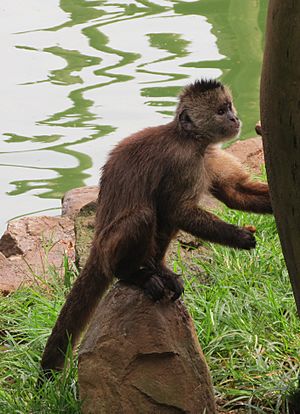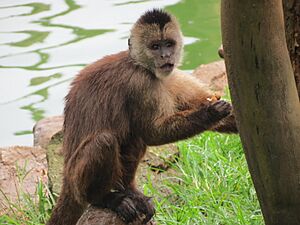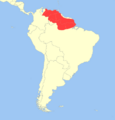Wedge-capped capuchin facts for kids
The wedge-capped capuchin (Cebus olivaceus) is a type of capuchin monkey found in South America. You can find them in northern Brazil, Guyana, and Venezuela. These monkeys usually live in tall, untouched forests. They travel long distances each day through the trees.
Wedge-capped capuchins are medium-sized monkeys. They have special "wedge cap" markings on their heads. Their limbs are a bit longer than other capuchins, which helps them jump through the forest. Like other capuchin monkeys, they mostly eat fruits, insects, and other plant parts. Sometimes, they might eat small animals.
They have a cool trick: they rub millipedes on their fur! This happens a lot during the rainy season. Scientists think the millipedes release chemicals that might help keep mosquitoes away. Even though they are not an endangered species, many animals hunt them. These predators range from large birds like vultures to big cats like jaguars.
Wedge-capped capuchins live in groups of 5 to 30 monkeys. There are usually more females than males in a group. Each group has a pecking order, or a system of who is in charge. This order helps keep the group organized.
Quick facts for kids Wedge-capped capuchin |
|
|---|---|
 |
|
| A wedge-capped capuchin at the São Paulo Zoo | |
| Conservation status | |
| Scientific classification | |
| Genus: |
Cebus
|
| Species: |
olivaceus
|
 |
|
| Where they live (includes C. castaneus and C. brunneus) | |
Contents
What They Look Like
Size and Body
Adult wedge-capped capuchins weigh about 3 kilograms (about 6.6 pounds). Males are usually heavier than females. They get their name from a black triangle of dark fur on their foreheads. This "wedge cap" starts between their eyes and covers the top of their head. Their fur is generally light brown to brown. They might have yellow and gray colors on different parts of their bodies. Their faces do not have much hair and are surrounded by light brown or blonde fur.
Male wedge-capped capuchins are about 30% heavier than females. Males also have longer canine teeth. Their upper canine teeth are about 70% larger than females'. Their lower canine teeth are about 40% larger. This might be because males compete with each other for females.
How They Move
Wedge-capped capuchins spend a lot of time running and jumping. They move quickly through the tops of the trees. Because of this, they have longer limbs, especially their back legs. This helps them jump and move easily in the forest canopy.
Family Tree
Scientists have studied the Cebus genus, which includes the wedge-capped capuchin. They agree that the wedge-capped capuchin belongs to this group with four other species. These are C. apella, C. albifrons, C. capucinus, and C. kaapori. The wedge-capped capuchin is closely related to C. apella.
Where They Live
Wedge-capped capuchins like to live in untouched primary forests. These are forests where they can move easily through the tree canopy. They live in the rainforests of northern Brazil and Venezuela. They also live in drier forests along rivers in Guyana.
These monkeys prefer dense, tall forests. They are found north of the Orinoco River. Their range goes south of the Sierra de Perijá and Venezuelan Coastal Range. To the east, they reach the Essequibo River in western Guyana.
What They Eat
Wedge-capped capuchins are omnivores. This means they eat both plants and animals. What they eat changes with the seasons, and also with their age and sex. Generally, they spend about equal time looking for plant and animal food. Baby monkeys, however, spend more time looking for plants.
Most of the plants they eat are ripe fruits, especially figs. They also eat palm nuts, seeds, berries, flowers, shoots, bark, and tree sap. Their animal food is mostly insects and other small creatures. They eat snails, spiders, wasps, caterpillars, grasshoppers, ants, and bird eggs. Some capuchins living near the coast also eat oysters, crabs, and other sea creatures.
Male and female capuchins spend similar amounts of time hunting insects. But they look for them in different places. Males search for insects on the surface of branches. Females mostly look for insects on top of palm trees. There is not much difference in the plant foods eaten by males and females. Older capuchins eat more animal food than younger ones.
Food Washing
Sometimes, wedge-capped capuchins wash their food. If their food is sandy, they might wash it before eating. This behavior has been seen in both monkeys living in the wild and those in zoos. Scientists think they wash food to solve a problem, like getting rid of sand. It does not seem to be something they learn by copying others.
Behavior and Social Life
Wedge-capped capuchins live in groups that can have from 5 to over 30 monkeys. A group usually has one adult male who mates, several adult females and their babies. Sometimes, there are also other adult males who do not mate. About half of a group's population is made up of young monkeys. There are usually more females than males. For every adult male, there can be more than 4 adult females. This happens because more females are born, and males often move to new groups.
Female capuchins between 6 and 26 years old can give birth about every two years. Older females (over 26 years) might only give birth every three or four years. Both male and female wedge-capped capuchins can live for as long as 36 years.
Young males usually leave their birth group when they are between 3 and 6 years old. They do not spend much time alone. They quickly join a new group. Males prefer to join groups with many females and few other adult males. This gives them a better chance to find a mate. When males join a new group, they usually do not face much resistance. Very rarely, older females might also move to new groups.
Who's in Charge?
Both male and female wedge-capped capuchins have a dominance hierarchy. This means there's a ranking system of who is more dominant. For females, a mother's rank often passes down to her daughters. So, dominant mothers tend to have dominant daughters. For males, dominance is not passed down as easily because males move between groups.
Females who are higher in rank tend to be more aggressive. They might act aggressively towards females and males who are lower in rank. Aggressive actions include lunging, making loud noises, and chasing. Sometimes, many females will chase males together. Male aggression is not usually linked to their rank. Male aggression towards females is mostly limited to vocalizations, lunging, and chasing.
Grooming
Grooming is very important for wedge-capped capuchins. It helps young males and females fit into the adult social structure. Young females rarely groom each other. Instead, they focus on grooming older females. These young females stay in their birth groups. They need to build relationships with adult females to become part of the adult female social group. Young females often try to groom adult females. The adult females who get groomed are usually less excited about it. This might mean that adult females do not gain as much from these grooming sessions as the younger females do. Young females who do not build relationships with older females might become outsiders in the group. They might also lose access to important resources.
Grooming among adult females is different. Females often groom individuals who are lower in rank than them. This might be because adult females use two different grooming strategies. One is called "appeasement." When a dominant female approaches a lower-ranking female, the lower-ranking female might lie down and ask to be groomed. This is a way to avoid aggressive behavior from the dominant female. This type of grooming is usually not returned by the lower-ranking female.
The other type of grooming is "affiliative." This type of grooming depends on both monkeys grooming each other. It usually happens between monkeys who are high or in the middle of the dominance hierarchy. This type of grooming helps females form alliances. These alliances can give them social and material benefits.
Alloparenting
Allomaternal care is when someone other than a baby's mother helps take care of it. This is common in wedge-capped capuchins. Other monkeys might nurse or carry the baby. For the first three months, only the mother cares for her baby. But in the next three months, allomaternal care increases a lot. Babies might even get less care from their mothers than from other females. Siblings provide much more care for babies than monkeys who are not related. Also, high-ranking females interact more with the babies of low-ranking females. Young monkeys and young adults provide the most alloparental care. Adult females do not participate as much. This is common in many primate groups. It helps young females gain valuable experience in raising babies, which will help them in the future.
It is interesting that allomaternal nursing (when another female nurses a baby) is common in wedge-capped capuchins. But it is very rare in other primates. This nursing behavior in wedge-capped capuchins is not related to how closely they are related. This behavior might be an example of reciprocity. This means one female nurses another's baby, and the favor is eventually returned.
Sometimes, "parasitic nursing" is also seen. In these cases, young females, who are usually higher in rank, nurse from older, lower-ranking females. Unlike allomaternal care, parasitic nursing does not seem to benefit the monkey providing the milk.
Rubbing with Millipedes
Wedge-capped capuchins sometimes rub themselves with millipedes they find. They rub the millipede on their fur for up to two minutes. They might also put the millipede in their mouths, take it out, and keep rubbing it on their bodies. These capuchins often share millipedes with each other.
Scientists are not sure why they do this strange behavior. One idea is that millipedes release chemicals when they feel threatened. These chemicals might act like insect repellent against mosquitoes. This behavior is most common during the rainy season, when there are many mosquitoes.
Who Hunts Them?
Wedge-capped capuchins make alarm calls if they see a possible predator. Their predators include jaguars, ocelots, tayras, boa constrictors, caimans, anacondas, and collared peccarys. They also make alarm calls when they see certain birds. These birds include hook-billed kites, black vultures, green ibises, rufous-vented chachalacas, harpy eagles, and ornate hawk-eagles. Because of these predators, wedge-capped capuchins live in groups. When a group is larger, each monkey needs to be less watchful.
Threats and How They Are Protected
The wedge-capped capuchin is listed as an animal of "least concern" by the IUCN Red List of Threatened Species. This means they are not currently in danger of extinction. They are common and live in many different places. However, human hunting is a big threat to capuchins in some areas.
Images for kids
See also
 In Spanish: Mono Capuchino para niños
In Spanish: Mono Capuchino para niños





